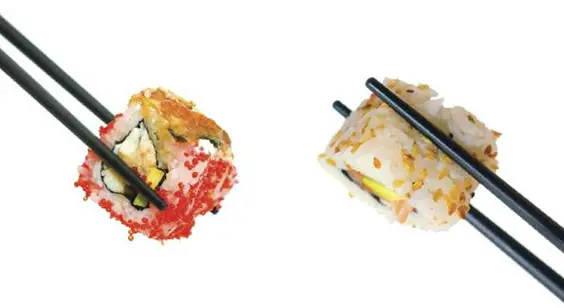Sushi for Beginners – A Novice’s Guide to Eating Sushi

A Novice’s Guide to Eating Sushi
by Alison Holland
In the last decade, sushi has become one of the trendiest, tastiest and healthiest food options around. The number of sushi restaurants found in major cities has quadrupled and an international population of avid-sushi lovers has emerged.
When the festive season is long behind us and Spring, once again, on the horizon, the impossible task remains: how to achieve both a satisfied appetite and a whittled waistline. Eating a generous amount of sushi this year is a practical New Year’s Resolution; packed with nutritious ingredients and a fusion of delicious flavors, sushi is the healthy, sustainable and tasty choice.
Contrary to popular belief, the term sushi does not mean only raw fish. Rather, the term refers to vinegar rice topped with other ingredients. There are many different types of sushi including the popular nigiri-sushi and maki-sushi rolls. Nigiri-sushi is sushi that often contains slices of raw tuna, salmon and prawn, on a pad of rice. Maki-sushi is rolled sushi, consisting of fish, fresh vegetables or other ingredients rolled up inside a thin sheet of nori (seaweed) and seasoned rice. Maki-sushi is cut into bite-sized pieces and can easily be eaten with chopsticks.
“Sushi is one of the reasons why the Japanese population is amongst the healthiest in the world”
Sushi appeals to a wide range of people because of the different options available. Most sushi restaurants often offer a seemingly endless amount of dishes that appeal to an array of appetites. Vegetarian sushi options, generally consisting of fresh vegetable in rice and nori, is readily available at most sushi restaurants.
Sushi is one of the reasons why the Japanese population is amongst the healthiest in the world. It consists of healthy and fresh ingredients that offer a tremendous amount of health benefits.
Fish
Most sushi options contain fish, which is abundant in Omega-3 fatty acids. These healthy fats are essential to the human diet as we do not synthesise them biologically. Omega-3 is considered to be ‘brain food’, helping ensure optimal functioning of the brain. In addition, Omega-3 is scientifically proven to naturally lower cholesterol and high blood pressure, as well as moderate blood sugar levels. The fresh fish found in sushi is a great source of low calorie, low fat and high quality protein. Fish also provides a high number of B vitamins known to improve energy levels.
Seaweed
Sushi often contains seaweed, which not only enhances the flavor of the sushi, but also contains a high vitamin and mineral content including calcium, potassium, iodine, iron and zinc, all of which are part of a healthy diet
Rice
Widely known to provide sustainable energy, rice helps make up the suggested 30 percent carbohydrate component of every meal. Sushi restaurants are slowly beginning to offer sushi made with brown rice instead of white. Full of nutrients and fibre, brown rice is healthier alternative to white rice.
“Mix wasabi with soy sauce to create a flavourful dipping sauce”
Soya Sauce
Soya Sauce is composed of permeated soya beans. The soya beans can protect against cancer and cardiovascular disease, promote healthy bones and help alleviate menopausal symptoms. If you are watching your sodium intake, make sure to request low-sodium soy sauce, as regular soy sauce often contains high amounts of sodium.
Wasabi
A green paste, often served on the side of sushi dishes. You can mix wasabi with soy sauce to create a flavorful dipping sauce. It contains a compound called isothiocyanates, which a recent scientific study has shown helps fight tooth decay. In addition, research also shows when you consume wasabi regularly, it can prevent blood clots and even aid in the prevention of cancer.
Ginger
Many people eat sushi with ginger to enhance the flavor. Ginger is known to aid digestion and prevent colds and respiratory illnesses.











